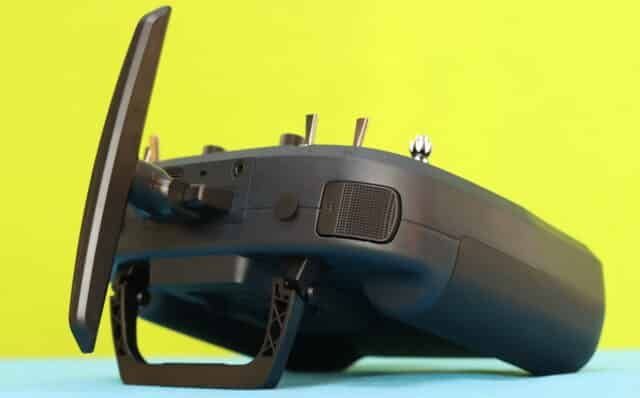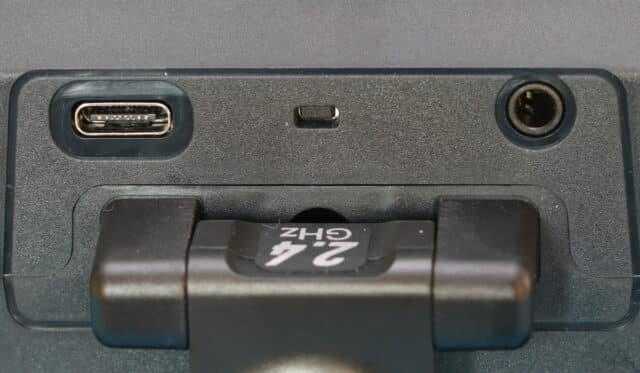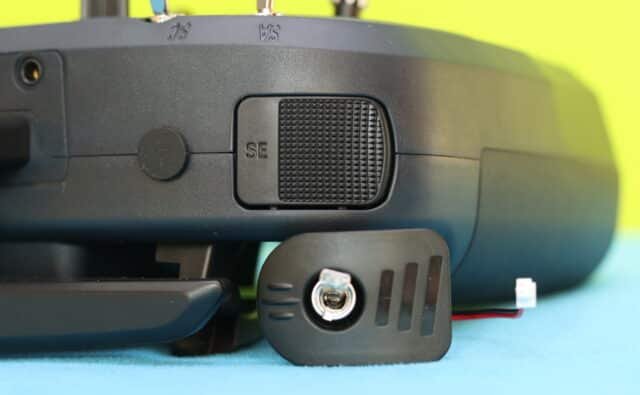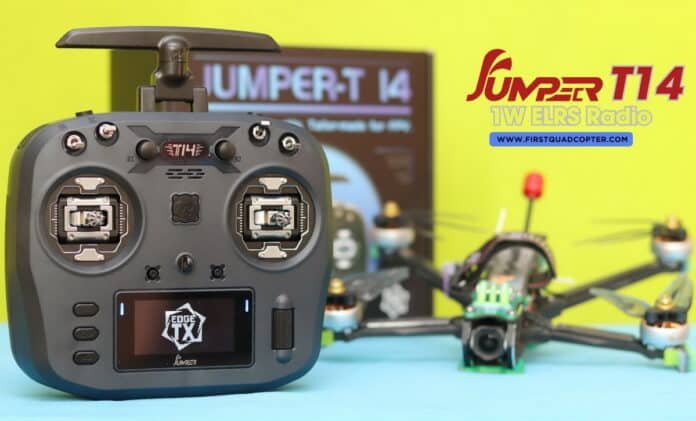The Jumper T14 is the company’s third radio controller reviewed here on FirstQuadcotper. The T14 is a mid-level transmitter with a built-in 1W ERLS module. It adopts RadioMaster Boxer and TBS Mambo-like form, factor, and layout. Not everything about the T14 is whoa-inducing; it lacks flight mode buttons, and the antenna is not removable for upgrade purposes.
JumperRC released the T14 with two gimbal versions and three ExpressLRS frequency options (868MHz, 915MHz, and 2.4GHz). The price difference between standard Hall sensor gimbals and CNC gimbals is about 30 bucks. It is not a bad deal, considering that a pair of RDC90 gimbals is $59.99. The radio controller is probably the longest-lasting component in the backpack of an FPV drone pilot, so it is worth choosing one that will not only satisfy all your technical needs but be comfortable to use, and you’ll also like how it looks.
Like most similar radios, the Jumper T14 also runs on EdgeTX, probably the most popular open-source firmware for remote control transmitters. Instead of an external micro SD slot, it has an onboard 512MB flash memory to store system files, voice prompts, and radio backups (you can store up to 60 models).
Jumper T14 radio controller review
Disclosure: I received this FPV radio controller from JumperRC to test it and do an in-depth review. Although the RC was offered for free, all opinions in this article remain my own, with no influence from my partner.
Like the T20 Gemini, the new T14 also comes in a nice handbag with the following accessories: a neck strap, USB-C data\charging cable, and spare tension springs. Additionally, JumperRC includes a shoulder switch upgrade kit.
The carry bag has a meshed internal pocket for the small accessories and a velcro band that secures the radio inside the case. The gimbals are protected with some basic foam cylinders.
Like its contenders (Boxer and Tango), the Jumper T14 also has a box form factor with an approximate size of 185*175*79mm. Without batteries, the transmitter weighs roughly 500 grams. On the back is a cheapy plastic foldable handler and a standard JR extension bay. The handle complicates things a bit when you load an external module. You can add compatibility with TBS Crossfire receivers and even toy drone receivers through the JR bay without any issues.
It has anti-slip rubber inserts on the back to provide a good grip. Holding it feels comfortable; all the controls are easily accessible regardless of whether you are a thumber or a hybrid pincher.

I like the T14 Jumper’s foldable and rotatable antenna. It makes the radio packable and allows it to match the RX’s antenna position (horizontal/vertical) for the best signal strength. The antenna is connected directly to the RF board, so upgrading to a 2.4 GHz ELRS MOXON directional antenna will be complicated (you must disassemble the entire radio).

On top, between the Type-C port for firmware updates, data transfer, and FPV simulators and the 3.5mm trainer port, there is a tiny sunken button with an unknown purpose.
My review unit came with the silver RDC90 gimbals. In the video below, you can see how to adjust stick travel distances and stick height. Unfortunately, you must remove the radio’s front panel to adjust the gimbal tension. Three spare springs are included (in case you lose it).
Jumper T14: Battery options, charging, and working time
The T14 can be powered from 6.0V to 8.4V. Natively, it is intended to be used with two 21700 LIION batteries. As the 18650 cells are 5mm shorter than the 21700, you need to bring the battery contacts closer together when you use this type of battery(reduce the distance between positive and negative leads to hold the battery securely).
After testing it for a whole day, I charge it back via the USB-C port using a 5V/5A charger. From almost zero (3V/cell) to full, it took around 3 hours for 3000mAh cells, meaning it has about 10W of charging power.

Being concerned about the health risk it may cause, I am afraid to use any radio device over 500 mW close to my body, so I set the T-14 to 500 mW (half its max power) with dynamic power enabled -this power setting allowed me about 4-5 hours of working time.
Jumper T14: Switches/Rotary knobs/Trims
The Jumper T14 is intended for FPV pilots who don’t need a wide variety of control options. On the front panel are four switches, one 2-position and one 3-position switch on each corner (SA, SC, SD, and SR). In the middle, right above the speaker, are two rotatory knobs (S1 and S2) with a center indent. There are no dedicated flight mode buttons, just two mini 4D joysticks for trimming.

Out of the box, it comes with two low-profile, button-style shoulder switches. The left is a latching (on/off) switch, and the right is a momentary one. Jumper-RC includes a modification kit if you prefer the classic stick-style metal switches instead of those push buttons (see photo below).

Jumper T14: Screen, Controls, Status LEDs and Menus
I loved T14’s big screen from the first power ON. Finally, JumperRC realized that size matters; both of my Jumper transmitters have a tiny screen that is difficult to read for people past the prime of youth like me.
The Power button with the Jumper logo is close to the center of the RC, located between the speaker and neck strap hook. The status LED is moved from the on/off switch to the sides of the 2.4″ monochrome OLED screen.

If you have ever used a Jumper radio, navigating the T14’s menu will be straightforward, thanks to a standard control layout with a scroll wheel and three buttons (SYS, Page, and RTN). You can enter into radio setting pages by short the “Sys” button, and by long pressing, you can access the ELRS LUA script interface.
Jumper T14: Technical specifications
| MCU | STM32F407ZET6 |
| OS | EDGETX |
| Gimbals | Hall sensor or RDC90 |
| Channel controls | 1x Momentary switch 1x Latching switch 2x Two Positions Switches 2x Three Positions Switches 2x Rotary dials |
| Radio controls | Dial Wheal SYS, Page, and RTN buttons |
| Trim buttons | Yes |
| Screen | 2.42″ OLED (resolution 128*64) |
| Built-in RF | ExpressLRS (868MHz, 915MHz or 2.4GHz) |
| Transmission power | Max 1Watt (30dBm), configurable via LUA script |
| Antenna | Not replaceable but foldable (Horizontal/Vertical) |
| Extension bay | Standard JR module (JR / FrSKY / Crossfire) |
| Storage | Integrated 512MB |
| Battery options | 2×21700 (natively) or 2×18650 |
| Working voltage | 6V – 8.4V |
| Dimensions | 185*175*79mm |
| Weight | W/o batteries: 500grams With two 18650: 590grams |
| Price | Standard Hall Sensor Gimbal – $89.99 CNC Hall Sensor Gimbal – $109.99 |
Pricing, availability, and options
As mentioned at the beginning of my review, the T14 radio has two types of gimbals (HALL and CNC) and three ELRS frequency options (2.4GHz / 915MHz / 868MHz). The Jumper T14 is available to order from February 2024 at many popular RC retailers, including NewBeeDrone and Banggood, and platforms like Amazon and Aliexpress. The model with CNC gimbal shown in this review is priced at $109.99. A compatible transparent case is available for 16 bucks.
Jumper T14: User experience and performance
Despite its compact size, the T14 is a versatile and fully capable EdgeTX transmitter. The fast 10W USB charging is welcomed for those who fly a lot. With limited control options, the Jumper T14 is a good choice for FPV drones, simpler gliders, and drone simulators.
ExpressLRS is known for its excellent performance and long-range capabilities. The maximum flight distance record at 500mW@50Hz is 11.47 km. If you prioritize responsiveness and latency, the T14’s built-in ELRS TX supports up to a 1000Hz package rate.
I tested the Jumper T14’s performance using my long-range Chimera 9 ECO drone equipped with a SuperD ELRS 2.4G receiver and DJI O3 Air Unit. I had a stable radio signal on the entire FPV range. I should mention that the T14 is not compatible with ELRS Gemini (true diversity dual channel transmission), as it only has one RF module.
During use, I don’t particularly appreciate that the cooling fan starts even at the lowest power setting (25 mW), making the radio noisy. I prefer enjoying the sound of nature, especially in the spring when the birds are chirping.
Jumper T14 vs Jumper T20 Gemini
When choosing between the T14 and T20G, consider the T14’s benefits, including a bigger OLED screen, the capability to support external modules directly without requiring an adapter, and its friendly price tag. On the other hand, if you prioritize the compact form factor, more reliable ELRS communication, and the diversity of controls, the T20G is probably a better option for you. In the table below, I compared the most important specs of these two radios.

| Jumper T14 | Jumper T20 | |
| Display | 2.42″ OLED (128*64) | 1.3″ OLED (128*64) |
| Channels | 7 | 15 |
| Flight mode buttons | None | 6 |
| Gimbal | HALL Sensor | Full-size RDC90 |
| Built-in TX | 1x1000mW ELRS | 2x500mW ELRS |
| Extension port | Standard JR bay | Dedicated extension port |
| ELRS Gemini | No | Yes |
| Battery options | 2×18650, or 2×21700 Li-ion cells | 2S LIPO, 2×18650, or 2×21700 Li-ion cells |
| Size | 18.5×17.5×7.9mm | 10x50x12cm |
| Weight | 500grams | 425 grams |
| Price | $89.99/$109.99 | $199.99 |
Jumper T14 alternatives: RadioMaster Boxer and TBS Mambo
The Jumper T14 reassembles the RadioMaster Boxer’s design in many aspects. It has the same square shape with a comparable layout and arrangement of switches. The TBS Mambo also shares a similar design and functionalities. Both the Mambo and Boxer have a starting price of $139.9, making them more expensive than the T14.
You Can Trust Our Reviews!
Since 2014, FirstQuadcopter has reviewed, thoroughly tested, and rated hundreds of products, including drones, gimbals, power stations, action cameras, 3D printers, and other high-tech gear to help you make better buying decisions.





The T14 can be installed with EDGETX V3?
Hey.
How do I set a binding phrase for my ELRS RXs and the Jumper T14?
I just received my Jumper T14 radio, and one of the sticks feels like the tension springs are weak. How can the problem be fixed?
HI, where can I get a 2 position switch for my T14 radio?
I was skeptical about buying a radio from a brand I wasn’t familiar with, but I’m glad I did. This Jumper works great and is very easy to program. Definitely worth every penny!!!
What’s the range with a 100mw Rx?
this looks pretty cool for 100bucks!